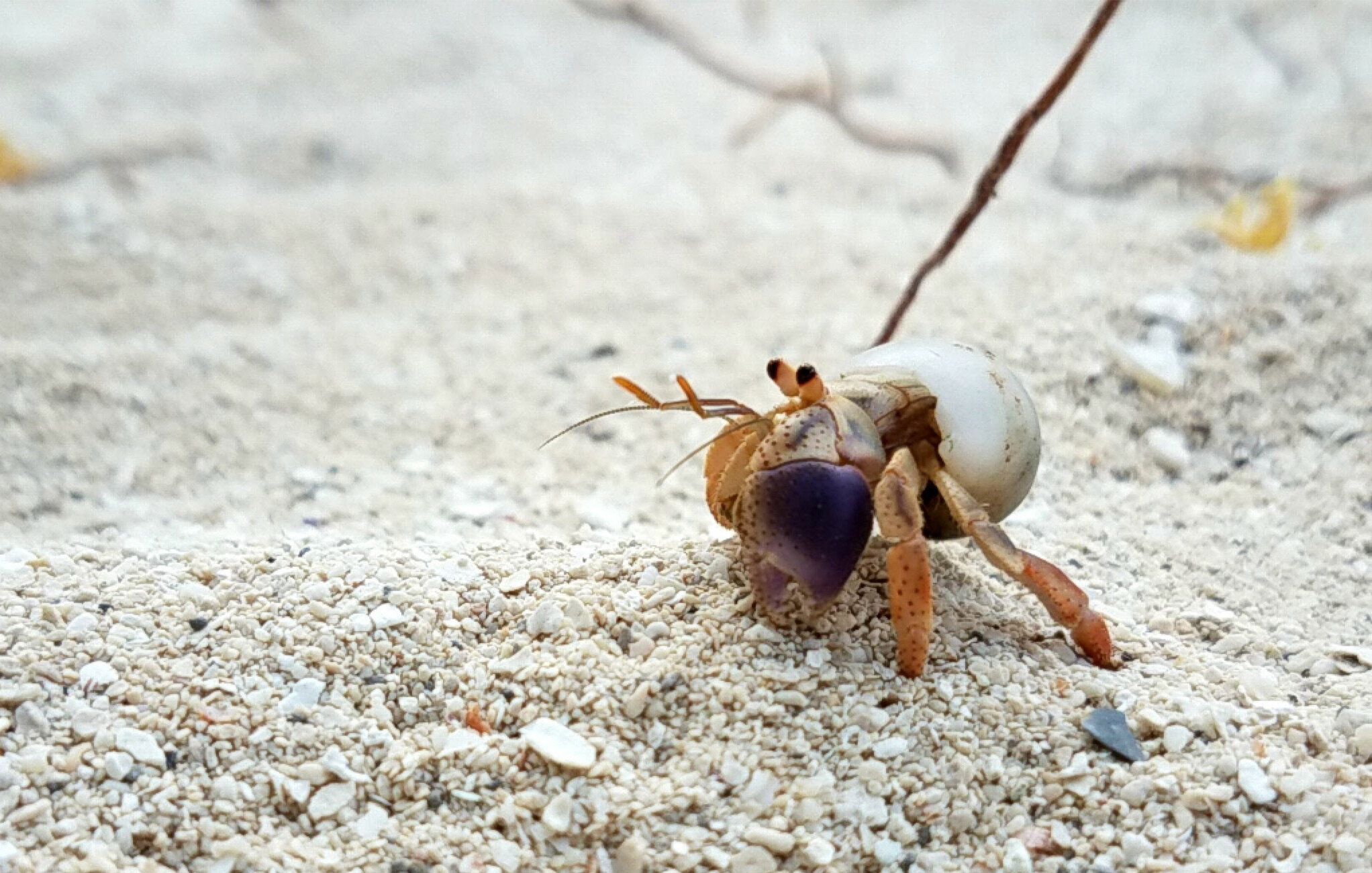SPECIES: HERMIT CRAB
Photo by Dr Jennifer Lavers
Despite their name, hermit crabs are not solitary creatures – as crabs go, they’re actually pretty social. They live in large colonies of a hundred or more, collaborating in teams to find food, and often sleep piled up together. Unlike other crabs, their hard exoskeleton covers only the front of their bodies, so they seek out shells, usually from sea snails, to protect their soft tails – but will settle for a plastic bottle cap if they stumble upon it first.
In the wild, hermit crabs can live up to 40 years if they manage to avoid the huge amounts of plastic we keep sending their way. Being such collaborative animals, hermit crabs release a pheromone when they die to signal to others that a spare shell has become available, leading even more crabs to their death: a 2020 study found that around 570,000 hermit crabs die from getting trapped in plastic debris every year on two tiny islands alone – Keeling Island in the Indian Ocean, and Henderson Island in the Southern Pacific. Sarah Gilliand, an ecologist at the Environmental Protection Agency who devoted her graduate thesis to these amazing creatures, explains why.
WHAT MAKES HERMIT CRABS UNIQUE?
Hermit crabs have very soft bodies, so they have to find some sort of shelter to protect themselves from threats like predation, changes in salinity, and drying out. Most hermit crabs seek out snail shells as their preferred form of shelter, and they’ve actually evolved to have curved abdomens to better fit into these shells. Also, their fourth and fifth sets of legs are smaller than their other legs, to better fit the interior of the shells and hold the shells in place. Hermit crabs rarely kill gastropods for their shells – they use shells left behind by gastropods after they’ve died and decomposed.
DO WE KNOW HOW THEY EVOLVED – AND WHY THEY STARTED USING SHELLS?
There are still a lot of questions about how exactly hermit crabs ended up in their current form. Fossil records show that hermit crabs likely appeared during the Jurassic Period and occupied empty ammonite shells until empty gastropod shells became abundant during the Cretaceous Period and provided a thicker, more portable shelter.
WHAT DREW YOU TO STUDYING THEM?
The intertidal zone is the area on the shore that is underwater at high tide but exposed to the air at low tide. Studying marine creatures that inhabit the intertidal zone appealed to me because of how drastically their environment can change over the course of a few hours or even minutes. When the tide goes out, hermit crabs and other organisms can be stranded on land or in tide pools, where the temperature and salinity of the water can change very quickly. When the tide comes back in, the tide pools are inundated with water that might be at a very different temperature and salinity. These fluctuating conditions might not make the intertidal zone the ideal place to live, but many species are driven there by competition, predation, or the need for certain resources. Not all hermit crabs live in the intertidal zone, but we were interested in understanding how those that do are affected by the dynamic environment.
WHAT CAN HERMIT CRABS TEACH US ABOUT THE OCEANS – AND PLASTIC POLLUTION?
Hermit crabs’ dependence on gastropod shells for survival illustrates that many of the organisms that live in or near our world’s oceans have evolved complex and interesting relationships with other organisms. The lives of so many species are intertwined in ways we might not even know, and interfering with the health of the oceans can have far reaching impacts.
Plastic pollution in the oceans has been a major concern for a long time. On some beaches you might see a hermit crab using pieces of plastic, like water bottle caps, as shelter. While a hermit crab in a colorful piece of plastic might look cute, it should signal to us that plastics are becoming more and more common in oceans and on beaches. These plastics can entangle marine creatures or look like a snack to birds flying overhead. Ten million tons of plastic a year finds its way into the oceans, and the work that’s being done to raise awareness of the issue is so important.
HOW COMMON IS IT FOR HERMIT CRABS TO INHABIT PIECES OF PLASTIC?
Hermit crabs will use any sort of shelter they can find, and if they’re not able to find adequate shells, a suitably sized piece of plastic could look attractive. On some beaches, tourists collect all the shells that hermit crabs would normally use, leaving the hermit crabs no choice but to settle for a piece of plastic that it doesn’t fit into as well.






